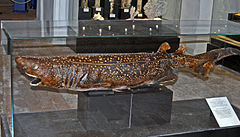Echinorhinidae
|
Echinorhinus Temporal range: 84–0 Ma Campanian to present |
|
|---|---|
 |
|
| Bramble shark, Echinorhinus brucus | |
 |
|
| Echinorhinus brucus, mounted specimen, on display at the Museo storia naturale di Pisa | |
| Scientific classification | |
| Kingdom: | Animalia |
| Phylum: | Chordata |
| Class: | Chondrichthyes |
| Subclass: | Elasmobranchii |
| Superorder: | Selachimorpha |
| Order: | Squaliformes |
| Family: |
Echinorhinidae T. N. Gill, 1862 |
| Genus: |
Echinorhinus Blainville, 1816 |
 |
|
| The distribution of the two Echinorhinus species | |
Echinorhinus is the only extant genus in the family Echinorhinidae.
While some scientists have proposed that the Echinorhinidae be given an order separate from Squaliformes, the general current consensus is that the Echinorhinidae are still a family in the order Squaliformes.
The name is from Greek echinos meaning "spiny" and rhinos meaning "nose".
This genus includes two extant species of uncommon, little-known sharks. Both species are relatively large sharks, at 3.1 to 4.0 m (10.2 to 13.1 ft) in body length. They are characterized by a short nose and by rough, thorn-like dermal denticles scattered over its body, some of which may be fused together. They have no anal fin. Two small spineless dorsal fins are positioned far back.
They are ovoviviparous, with the mother retaining the egg-cases inside her body until they hatch, producing litters up to 24 pups. They feed on smaller sharks, smaller bony fish, and on crabs and cephalopods.
These sharks are found worldwide in cold temperate to tropical seas from the surface down to 900 m (3,000 ft).
...
Wikipedia
